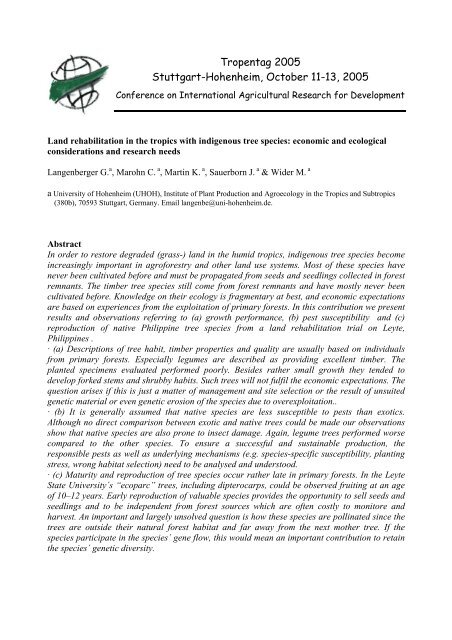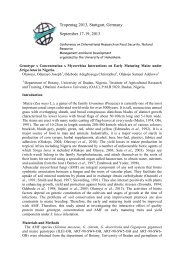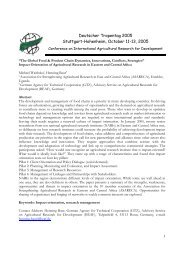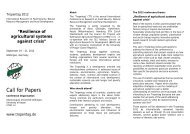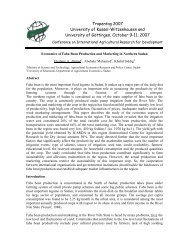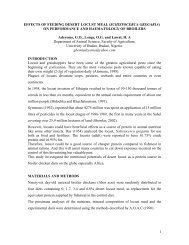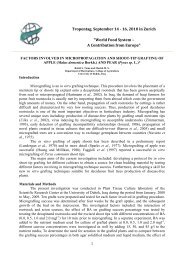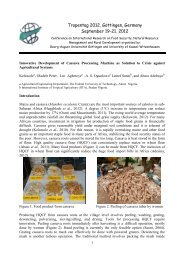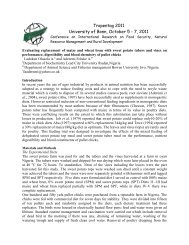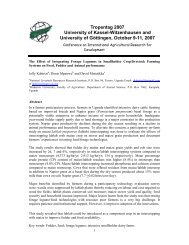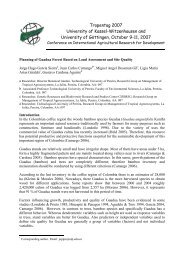Land Rehabilitation in the Tropics with Indigenous Tree ... - Tropentag
Land Rehabilitation in the Tropics with Indigenous Tree ... - Tropentag
Land Rehabilitation in the Tropics with Indigenous Tree ... - Tropentag
Create successful ePaper yourself
Turn your PDF publications into a flip-book with our unique Google optimized e-Paper software.
<strong>Tropentag</strong> 2005<br />
Stuttgart-Hohenheim, October 11-13, 2005<br />
Conference on International Agricultural Research for Development<br />
<strong>Land</strong> rehabilitation <strong>in</strong> <strong>the</strong> tropics <strong>with</strong> <strong>in</strong>digenous tree species: economic and ecological<br />
considerations and research needs<br />
a a<br />
Langenberger G. , Marohn C. , Mart<strong>in</strong> K. a , Sauerborn J. a & Wider M. a<br />
a University of Hohenheim (UHOH), Institute of Plant Production and Agroecology <strong>in</strong> <strong>the</strong> <strong>Tropics</strong> and Subtropics<br />
(380b), 70593 Stuttgart, Germany. Email langenbe@uni-hohenheim.de.<br />
Abstract<br />
In order to restore degraded (grass-) land <strong>in</strong> <strong>the</strong> humid tropics, <strong>in</strong>digenous tree species become<br />
<strong>in</strong>creas<strong>in</strong>gly important <strong>in</strong> agroforestry and o<strong>the</strong>r land use systems. Most of <strong>the</strong>se species have<br />
never been cultivated before and must be propagated from seeds and seedl<strong>in</strong>gs collected <strong>in</strong> forest<br />
remnants. The timber tree species still come from forest remnants and have mostly never been<br />
cultivated before. Knowledge on <strong>the</strong>ir ecology is fragmentary at best, and economic expectations<br />
are based on experiences from <strong>the</strong> exploitation of primary forests. In this contribution we present<br />
results and observations referr<strong>in</strong>g to (a) growth performance, (b) pest susceptibility and (c)<br />
reproduction of native Philipp<strong>in</strong>e tree species from a land rehabilitation trial on Leyte,<br />
Philipp<strong>in</strong>es .<br />
· (a) Descriptions of tree habit, timber properties and quality are usually based on <strong>in</strong>dividuals<br />
from primary forests. Especially legumes are described as provid<strong>in</strong>g excellent timber. The<br />
planted specimens evaluated performed poorly. Besides ra<strong>the</strong>r small growth <strong>the</strong>y tended to<br />
develop forked stems and shrubby habits. Such trees will not fulfil <strong>the</strong> economic expectations. The<br />
question arises if this is just a matter of management and site selection or <strong>the</strong> result of unsuited<br />
genetic material or even genetic erosion of <strong>the</strong> species due to overexploitation..<br />
· (b) It is generally assumed that native species are less susceptible to pests than exotics.<br />
Although no direct comparison between exotic and native trees could be made our observations<br />
show that native species are also prone to <strong>in</strong>sect damage. Aga<strong>in</strong>, legume trees performed worse<br />
compared to <strong>the</strong> o<strong>the</strong>r species. To ensure a successful and susta<strong>in</strong>able production, <strong>the</strong><br />
responsible pests as well as underly<strong>in</strong>g mechanisms (e.g. species-specific susceptibility, plant<strong>in</strong>g<br />
stress, wrong habitat selection) need to be analysed and understood.<br />
· (c) Maturity and reproduction of tree species occur ra<strong>the</strong>r late <strong>in</strong> primary forests. In <strong>the</strong> Leyte<br />
State University´s “ecoparc” trees, <strong>in</strong>clud<strong>in</strong>g dipterocarps, could be observed fruit<strong>in</strong>g at an age<br />
of 10–12 years. Early reproduction of valuable species provides <strong>the</strong> opportunity to sell seeds and<br />
seedl<strong>in</strong>gs and to be <strong>in</strong>dependent from forest sources which are often costly to monitore and<br />
harvest. An important and largely unsolved question is how <strong>the</strong>se species are poll<strong>in</strong>ated s<strong>in</strong>ce <strong>the</strong><br />
trees are outside <strong>the</strong>ir natural forest habitat and far away from <strong>the</strong> next mo<strong>the</strong>r tree. If <strong>the</strong><br />
species participate <strong>in</strong> <strong>the</strong> species´ gene flow, this would mean an important contribution to reta<strong>in</strong><br />
<strong>the</strong> species´ genetic diversity.
Introduction<br />
Native tree species become <strong>in</strong>creas<strong>in</strong>gly important <strong>in</strong> land rehabilitation (e.g. Butterfield & Fisher<br />
1994, Butterfield 1995). Additionally, a trend can be observed to establish mixed species stands<br />
<strong>in</strong>stead of monocultures. The most sophisticated approach currently observable is to imitate<br />
orig<strong>in</strong>al forest structure and processes to create so-called ‘successional analogs’ or ‘analogs’<br />
(Ashton & Ducey 2000, Ewel 1999). It is assumed that - due to <strong>the</strong>ir high ecological diversity -<br />
such forests are less susceptible to pests and much more stable and susta<strong>in</strong>able compared to<br />
monocultures. Additionally, <strong>the</strong>y are much better suited to provide a wide variety of goods and<br />
benefits to rural people and thus to contribute to <strong>the</strong>ir livelihood.<br />
Most <strong>in</strong>digenous tree species used for establish<strong>in</strong>g ‘analogs’ have never been cultivated before,<br />
and <strong>the</strong> seeds or seedl<strong>in</strong>gs required are usually collected from forest remnants. Knowledge on <strong>the</strong><br />
ecology of such species is fragmentary at best, and economically relevant data as tree dimensions,<br />
growth habit and timber quality are based on experience from <strong>the</strong> exploitation of primary forest<br />
(e.g. Whitford 1911a,b).<br />
In 1990ies, a land rehabilitation model named 'ra<strong>in</strong>forestation farm<strong>in</strong>g' (Milan & Margraf 1994)<br />
resembl<strong>in</strong>g <strong>the</strong> idea of ‘successional analogs’ has been developed on <strong>the</strong> island of Leyte,<br />
Philipp<strong>in</strong>es. Based on plant<strong>in</strong>gs established at that time we present observations and results<br />
consider<strong>in</strong>g growth performance, pest susceptibility, and reproduction of native tree species.<br />
Material and Methods<br />
In 1996, a c. 1 ha trial-plot <strong>in</strong> <strong>the</strong> lowland of <strong>the</strong> island of Leyte, Philipp<strong>in</strong>es, has been planted<br />
<strong>with</strong> 36 tree species by a farmer community. In 2004, we conducted a survey on <strong>the</strong> performance<br />
of <strong>the</strong>se species. Besides measur<strong>in</strong>g diameter and estimat<strong>in</strong>g height – we used median values to<br />
reduce impact of measur<strong>in</strong>g and estimation bias, respectively, we classified each <strong>in</strong>dividual tree<br />
accord<strong>in</strong>g to <strong>the</strong> amount of leaves show<strong>in</strong>g signs of herbivory (<strong>in</strong>sect damage) (class 0 = 0%<br />
leaves affected, 1 ≤ 25%, 2 ≤ 50%, 3 ≤ 75%, 4 ≤ 100%). Dead trees have been <strong>in</strong>cluded as class<br />
5. Additionally, we created <strong>the</strong> follow<strong>in</strong>g categories do get an overview on damages negatively<br />
affect<strong>in</strong>g future timber quality: none observable, forked stem, shoot damaged by <strong>in</strong>sects, shoot<br />
dead. S<strong>in</strong>ce quality features as forked stems are relevant for timber trees only, fruit trees have not<br />
been <strong>in</strong>cluded <strong>in</strong> this presentation except <strong>the</strong>y are also potential timber species. We only<br />
considered species represented by at least 20 <strong>in</strong>dividuals.<br />
The data on fruit sett<strong>in</strong>g of s<strong>in</strong>gle trees are based on observations <strong>in</strong> <strong>the</strong> ‘ecoparc’ of <strong>the</strong> Leyte<br />
State University (LSU), which is located only few kilometres away from <strong>the</strong> above mentioned<br />
trial-plot. The exact age of plants <strong>in</strong> <strong>the</strong> ‘ecoparc’ cannot be given s<strong>in</strong>ce it has been planted<br />
successively s<strong>in</strong>ce 1992 which results <strong>in</strong> a maximum age of 12 years. As typical for a parc area<br />
<strong>the</strong> trees have been planted widely spaced. Some growth data from ‘ecoparc’ trees are given<br />
where adequat.<br />
Results<br />
Especially <strong>the</strong> pioneer tree Casuar<strong>in</strong>a rumphiana (Mt. Agoho) showed a dom<strong>in</strong>ant growth<br />
performance, while late successional species as Hope spp. (Yakal, Dal<strong>in</strong>gd<strong>in</strong>gan) clearly stood<br />
beh<strong>in</strong>d (Tab. 1). Term<strong>in</strong>alia microcarpa (Kalumpit) and Vitex parviflora (Molave) also showed a<br />
comparatively good growth performance. By far <strong>the</strong> greatest dimension has been achieved by<br />
Melia dubia (Bagalunga), a species planted on <strong>the</strong> LSU campus and <strong>in</strong> <strong>the</strong> ‘ecoparc’,<br />
respectively. One tree <strong>in</strong> <strong>the</strong> ‘ecoparc’ had reached a dbh (diameter at breast height = 1.3m) of<br />
62cm and a measured height of 21,5m (Tab. 2). The branchless stem reached up to 6.4m.<br />
Insect damage of leafes was a common feature of most of <strong>the</strong> trees (Fig. 1). Least affected were<br />
Casuar<strong>in</strong>a rumphiana (Mt. Agoho) (see discussion) and Artocarpus odoratissima (Marang).<br />
Especially <strong>the</strong> legumes (Intsia bijuga, Ormosia calavensis, Pterocarpus <strong>in</strong>dicus) and <strong>the</strong><br />
dipterocarps (Parashorea malaanonan, Bagtikan, and Shorea contorta, White lauan) showed
comparatively high rates of <strong>in</strong>sect damage. More than 20% of <strong>the</strong> <strong>in</strong>dividuals of each legume<br />
species had to be classified <strong>in</strong> category IV (75% ≤ 100% affected leaves). Ormosia calavensis<br />
(Bahai) even reached a figure of 64%. The two dipterocarps had values of 29% (Parashorea<br />
malaanonan) and 36% (Shorea contorta), respectively. Besides high degrees of leaves damaged<br />
by <strong>in</strong>sects <strong>the</strong> two legumes Intsia bijuga (Ipil) and Pterocarpus <strong>in</strong>dicus (Narra) as well as <strong>the</strong><br />
Anacardiaceae Dracontomelon dao (Dao) had rates of dead <strong>in</strong>dividuals between 13% and 15%.<br />
Table 1: Growth performance of native Philipp<strong>in</strong>e tree species <strong>in</strong> a mixed-species plant<strong>in</strong>g-trial<br />
(c. 1 ha) on <strong>the</strong> island of Leyte, Philipp<strong>in</strong>es<br />
Local name 1 Scientific name Family height<br />
median / m<br />
diameter<br />
median / cm<br />
Apitong Dipterocarpus grandiflorus Dipterocarpaceae 4,5 3,5<br />
Bagtikan Parashorea malaanonan Dipterocarpaceae 4,5 3<br />
Bahay Ormosia calavensis Legum<strong>in</strong>osae 2,5 2<br />
Bitanghol Calophyllum blancoi Clusiaceae 5,5 5<br />
Dal<strong>in</strong>gd<strong>in</strong>gan Hopea sp. Dipterocarpaceae 3,5 2<br />
Dao Dracontomelon dao Anacardiaceae 3,5 2,5<br />
Ipil Intsia bijuga Legum<strong>in</strong>osae 5,5 5<br />
Kalumpit Term<strong>in</strong>alia microcarpa Combretaceae 6,5 6,5<br />
Malakauayan Podocarpus rumphii Podocarpaceae 4 4<br />
Marang Artocarpus odoratissima Moraceae 5,5 5<br />
Molave Vitex parviflora Verbenaceae (7,5) 2 (7,5) 2<br />
Mt. Agoho Casuar<strong>in</strong>a rumphiana 3 Casuar<strong>in</strong>aceae (14) 4 15<br />
Narra Pterocarpus <strong>in</strong>dicus Legum<strong>in</strong>osae 4 4<br />
Tamayuan Strombosia philipp<strong>in</strong>ensis Olacaceaea 4 3<br />
White Lauan Shorea contorta Dipterocarpaceae 4,5 3,5<br />
Yakal Hopea sp. Dipterocarpaceae 4,5 3<br />
1 Comon official name after Salvosa (1963).<br />
2 See discussion.<br />
3 The genus Casuar<strong>in</strong>a has been taxonomically split. Accord<strong>in</strong>g to <strong>the</strong> new classification C. rumphiana has been<br />
renamed <strong>in</strong>to Gymnostoma rumphianum. S<strong>in</strong>ce this name is locally nei<strong>the</strong>r known nor practiced <strong>the</strong> traditional<br />
name has been used.<br />
4 The height is def<strong>in</strong>itely too high and <strong>the</strong> result of overestimation. A realistic figure is c. 10 m.<br />
Most of <strong>the</strong> species and <strong>in</strong>dividuals evaluated didn´t show features hav<strong>in</strong>g impact on future wood<br />
quality (Fig. 2). To a lesser extend <strong>the</strong> diperocarps Shorea contorta (White Lauan), Parashorea<br />
malaanonan (Bagtikan), and Hopea spp. (Yakal, Dal<strong>in</strong>gd<strong>in</strong>gan) showed forked stems or dead or<br />
damaged shoots possibly lead<strong>in</strong>g to forked stems <strong>in</strong> <strong>the</strong> future. High rates of forked stems and<br />
damaged or dead shoots could be documented for <strong>the</strong> three legume species Intsia bijuga (Ipil),<br />
Pterocarpus <strong>in</strong>dicus (Narra), and Ormosia calavensis (Bahay). Ano<strong>the</strong>r legume species which<br />
has been present <strong>in</strong> LSU´s ‘ecoparc’ only, K<strong>in</strong>giodendron alternifolium (Batete), also showed <strong>the</strong><br />
tendency towards a shrubby growth.
100.0<br />
90.0<br />
80.0<br />
70.0<br />
60.0<br />
%<br />
50.0<br />
40.0<br />
30.0<br />
20.0<br />
10.0<br />
0.0<br />
Apitong (55)<br />
Bagtikan (727)<br />
Bahay (25)<br />
Bitanghol (348)<br />
Dal<strong>in</strong>gd<strong>in</strong>gan (356)<br />
Dao (160)<br />
Ipil (116)<br />
Kalumpit (336)<br />
Malakauayan (260)<br />
Marang (69)<br />
Molave (23)<br />
Mt. Agoho (44)<br />
Narra (23)<br />
Tamayuan (140)<br />
White Lauan (462)<br />
Yakal (251)<br />
Class 0 Class 1 Class 2 Class 3 Class 4 Class 5<br />
Fig. 1: Degree of leaf damage <strong>in</strong> different native tree species <strong>in</strong> a plant<strong>in</strong>g trial (c. 1 ha) on <strong>the</strong><br />
island of Leyte, Philipp<strong>in</strong>es<br />
The figures <strong>in</strong> brackets give <strong>the</strong> number of trees evaluated.<br />
Class 0: percentage of trees <strong>with</strong>out sign of leaf damages<br />
Class 1: percentage of trees which show <strong>in</strong>sect damage on up to 25% of <strong>the</strong>ir leafes<br />
Class 2: percentage of trees which show <strong>in</strong>sect damage on more than 25% up to 50% of <strong>the</strong>ir leafes<br />
Class 3: percentage of trees which show <strong>in</strong>sect damage on more than 50% up to 75% of <strong>the</strong>ir leafes<br />
Class 4: percentage of trees which show <strong>in</strong>sect damage on more than 75% of <strong>the</strong>ir leafes<br />
Class 5: percentage of dead <strong>in</strong>dividuals<br />
Fruit<strong>in</strong>g or flower<strong>in</strong>g has not yet been documented for trees of <strong>the</strong> plant<strong>in</strong>g-trial, while several<br />
species could be observed fruit<strong>in</strong>g <strong>in</strong> LSUs ‘ecoparc’ (Tab. 2) or along roadsides on <strong>the</strong> campus.<br />
None of <strong>the</strong> trees was older than 12 years. Dipterocarpus validus and Planchonia spectabilis<br />
developed only few fruits so far, while <strong>the</strong> o<strong>the</strong>r species produced at least small numbers. An<br />
exception was Hopea plagata, a typical late successional species, which showed already a mast<br />
fruit<strong>in</strong>g, although <strong>the</strong> trees were still small (6-8m high, 8-10cm diameter at 1.3m height). A<br />
detailled description of <strong>the</strong> dipterocarp fruit<strong>in</strong>g has been given by Langenberger (2005). Except<br />
for Hopea plagata, where germ<strong>in</strong>ation of seeds has been observed, no proof of viability can be<br />
given for <strong>the</strong> o<strong>the</strong>r species.
Table 2: Native tree species fruit<strong>in</strong>g on <strong>the</strong> campus and <strong>the</strong> ‘ecoparc’ of <strong>the</strong> Leyte State<br />
University (LSU) (age of <strong>the</strong> trees up to 12 years)<br />
Local name 1 Scientific name Family Observations on fruit<strong>in</strong>g 2<br />
- Cryptocarya sp. Lauraceae fruit<strong>in</strong>g 2004, dbh 20.1 cm, tree<br />
height 11.8m<br />
Hagaghak Dipterocarpus validus Dipterocarpaceae fruit<strong>in</strong>g 2003 & 2004, dbh 18 cm,<br />
tree height 13.5m<br />
Yakal Saplungan Hopea plagata Dipterocarpaceae fruit<strong>in</strong>g 2004, dbh 8-10cm, tree<br />
height 6-8m<br />
Batete<br />
K<strong>in</strong>giodendron Legum<strong>in</strong>osae fruit<strong>in</strong>g before 2003, already<br />
alternifolium<br />
Bagalunga Melia dubia Meliaceae fruit<strong>in</strong>g before 2003, already; dbh<br />
62cm, height 21,5m<br />
- Planchonia spectabilis Lecythidaceae fruit<strong>in</strong>g 2004, dbh 22.3cm, height<br />
11m<br />
- Spondias p<strong>in</strong>nata Anacardiaceae fruit<strong>in</strong>g before 2003, already<br />
Kalumpit Term<strong>in</strong>alia microcarpa Combretaceae mast fruit<strong>in</strong>g <strong>in</strong> 2004, probably even<br />
<strong>in</strong> earlier years<br />
Mangkono Xanthostemon<br />
verdugonianus<br />
Myrtaceae fruit<strong>in</strong>g before 2003, already<br />
1 Comon official name after Salvosa (1963).<br />
2 dbh = diameter at breast height (1.3m).<br />
100<br />
90<br />
80<br />
70<br />
60<br />
%<br />
50<br />
40<br />
30<br />
20<br />
10<br />
0<br />
Apitong (55)<br />
Bagtikan (715)<br />
Bahay (25)<br />
Bitanghol (340)<br />
Dal<strong>in</strong>gd<strong>in</strong>gan (355)<br />
Dao (131)<br />
Ipil (85)<br />
Kalumpit (320)<br />
Malakauayan (258)<br />
Marang (67)<br />
Molave (23)<br />
Mt. Agoho (44)<br />
Narra (19)<br />
Tamayuan (140)<br />
White Lauan (443)<br />
Yakal (247)<br />
none observable forked shoot damaged by <strong>in</strong>sects shoot dead<br />
Fig. 2: Damages observed <strong>in</strong> a mixed tree species plant<strong>in</strong>g trial (c. 1 ha) on <strong>the</strong> island of Leyte,<br />
Philipp<strong>in</strong>es, affect<strong>in</strong>g future wood quality<br />
Figures <strong>in</strong> brackets refer to <strong>the</strong> number of trees evaluated for <strong>the</strong> respective species
Discussion<br />
As could be expected at this early age pioneer tree species grew much faster compared to <strong>the</strong><br />
o<strong>the</strong>r species. Especially Mt. Agoho (Casuar<strong>in</strong>a rumphiana) was clearly ahead. Even though <strong>the</strong><br />
height estimation is strongly biased and a realistic figure of <strong>the</strong> average height at <strong>the</strong> time of<br />
evaluation is c. 10m, <strong>the</strong> measured diameter is double that of <strong>the</strong> o<strong>the</strong>r species. Kalumpit<br />
(Term<strong>in</strong>alia microcarpa) also performed well. S<strong>in</strong>ce <strong>the</strong> species has also been planted along<br />
roadsides on <strong>the</strong> campus of <strong>the</strong> Leyte State University (LSU) and performed evenly well <strong>the</strong>re –<br />
even produc<strong>in</strong>g large quantitites of seeds - it can be concluded that <strong>the</strong> species is well suited for<br />
local conditions. The evaluation of Molave (Vitex parviflora), which also shows comparatively<br />
big dimensions, is a bit more tricky. Molave can be found locally <strong>in</strong> secondary growth and<br />
degraded vegetation. Therefore, <strong>the</strong> figures for Molave might <strong>in</strong>clude trees which have not been<br />
planted but were already established when plant<strong>in</strong>g of <strong>the</strong> trial-plot was conducted. The most<br />
impressive figures are those from s<strong>in</strong>gle trees <strong>in</strong> <strong>the</strong> ‘ecoparc’ of LSU, especially that of<br />
Bagalunga (Melia dubia) (62cm dbh). But s<strong>in</strong>ce those trees grew up more or less as solitairs<br />
<strong>with</strong>out <strong>in</strong>tra- or <strong>in</strong>terspecific competition <strong>with</strong> o<strong>the</strong>r trees a generalization of growth<br />
performance must be done <strong>with</strong> care. Never<strong>the</strong>less, <strong>the</strong> species can reach large dimensions <strong>with</strong><strong>in</strong><br />
a very short time. S<strong>in</strong>ce - accord<strong>in</strong>g to local communications - <strong>the</strong> timber also achieves good<br />
prices this species can act as umbrella tree for late successional species and at <strong>the</strong> same time<br />
contribute to early <strong>in</strong>come <strong>in</strong> alternative land rehabilitation schemes like ‘ra<strong>in</strong>forestation’.<br />
A tree group which seems to be very problematic when planted are <strong>the</strong> legumes. They performed<br />
unexpectedly poor while <strong>the</strong> species evaluated here are described <strong>in</strong> literature as provid<strong>in</strong>g<br />
excellent timber and big dimensions. While big tree dimensions might be achieved <strong>with</strong> time <strong>the</strong><br />
quality usually required for sawn timber – s<strong>in</strong>gle stem, few small branches or even branchless,<br />
etc. – can not be expected based on <strong>the</strong> current observations. But, consider<strong>in</strong>g <strong>the</strong> small amounts<br />
of timber which might be produced <strong>in</strong> such mixed stands <strong>the</strong> production has very likely to be sold<br />
on local markets where quality requirements might not be so strict. The question arises if <strong>the</strong> poor<br />
quality performance of <strong>the</strong> legumes, especially <strong>the</strong> shrubby growth, is already <strong>the</strong> result of<br />
genetic erosion, that is k<strong>in</strong>d of a negative selection of mo<strong>the</strong>r trees due to <strong>the</strong> extraction of <strong>the</strong><br />
valuable <strong>in</strong>dividuals long ago, or if it is just a matter of management (e.g. spac<strong>in</strong>g of trees,<br />
prun<strong>in</strong>g) and site selection. Due to <strong>the</strong> high timber value of <strong>the</strong>se species mature trees have<br />
practically disappeared from local forests, and seeds have to be collected from <strong>the</strong> rema<strong>in</strong><strong>in</strong>g<br />
sources, that is poorly shaped trees. But it might also be that legume trees are very flexible<br />
consider<strong>in</strong>g <strong>the</strong>ir growth form. Thus, K<strong>in</strong>giodendron alternifolium (Batete), <strong>the</strong> only legume<br />
species which could still be found scattered <strong>in</strong> local forest fragments, developed good stem<br />
shapes <strong>with</strong><strong>in</strong> <strong>the</strong> closed forest but grew up as shrub <strong>in</strong> LSU’s ‘ecoparc’, which would stress <strong>the</strong><br />
latter assumption and <strong>the</strong> importance of proper management to achieve satisfactory results.<br />
It is generally assumed that native species are less susceptible to pests than exotics. The results<br />
show that native species are also affected to different degrees by <strong>in</strong>sect damage. But it should be<br />
clear that a/ this is how ecosystems work (trophic levels) and b/ this doesn´t proof that <strong>the</strong><br />
affected trees realy suffer. Only <strong>the</strong> damage to shoots result<strong>in</strong>g <strong>in</strong> several leader shoots and thus<br />
fork<strong>in</strong>g of stems clearly affect economic perspectives.<br />
Maturity and reproduction of late successional species, that is <strong>the</strong> typical species of old-growth<br />
forest, can usually be observed at a ra<strong>the</strong>r old age. In <strong>the</strong> Leyte State University´s “ecoparc” trees,<br />
<strong>in</strong>clud<strong>in</strong>g dipterocarps, could be observed fruit<strong>in</strong>g at an age of 10-12 years or even earlier. Early<br />
reproduction of valuable species provides <strong>the</strong> opportunity to sell seeds and seedl<strong>in</strong>gs and to be<br />
<strong>in</strong>dependent from forest sources which are often costly to monitore and harvest. An important<br />
and largely unsolved question is how <strong>the</strong>se species are poll<strong>in</strong>ated s<strong>in</strong>ce <strong>the</strong> trees are outside <strong>the</strong>ir<br />
natural forest habitat and far away from <strong>the</strong> next mo<strong>the</strong>r tree. If <strong>the</strong> species participate <strong>in</strong> <strong>the</strong><br />
species´ gene flow, this would mean an important contribution to reta<strong>in</strong> <strong>the</strong> species´ genetic<br />
diversity.
Mixed species plant<strong>in</strong>gs pose special difficulties on <strong>the</strong> evaluation of <strong>the</strong> performance of s<strong>in</strong>gle<br />
trees or species. Due to <strong>the</strong> heterogeneity of such stands <strong>the</strong> identification of patterns and key<br />
factors responsible for <strong>the</strong> performance is difficult. None <strong>the</strong> less, identification of species´<br />
habitat preferences and site-species <strong>in</strong>teractions, growth dynamics and plant-pest <strong>in</strong>teractions are<br />
a prerequisite to a successful management of such species and will be an important task for future<br />
tropical forest research. Additionally, <strong>the</strong> impact of mo<strong>the</strong>r tree quality on <strong>the</strong> performance of<br />
offspr<strong>in</strong>gs must be clarified for <strong>the</strong> different species. If legume species - which potentially<br />
provide high value timber – shall be part of management schemes, <strong>the</strong>y need special focus.<br />
References<br />
Ashton M.S. & Ducey M.J. 2000. Agroforestry systems as successional analogs to native forests.<br />
Pp. 207-228 <strong>in</strong> Ashton M.S. & Montagn<strong>in</strong>i F. (eds.): The Silvicultural Basis for<br />
Agroforestry Systems. CRC Press, Wash<strong>in</strong>gton, D.C.<br />
Butterfield R. P. & Fisher R. F. 1994. Untapped Potential: Native Species for Reforestation.<br />
Journal of Forestry 92 (6): 37-40.<br />
Butterfield R.P. 1995. Promot<strong>in</strong>g biodiversity: advances <strong>in</strong> evaluat<strong>in</strong>g native species for<br />
reforestation. Forest Ecology and Management 75: 111-121.<br />
Ewel J.J. 1999. Natural systems as models for <strong>the</strong> design of susta<strong>in</strong>able systems of land use.<br />
Agroforestry Systems 45: 1-21.<br />
Langenberger G. 2005. Age of first fruit<strong>in</strong>g <strong>in</strong> two planted Philipp<strong>in</strong>e dipterocarp species. Flora<br />
Malesiana Bullet<strong>in</strong> 13(4): 369-370.<br />
Milan P.P. & Margraf J. 1994. Ra<strong>in</strong>forestation farm<strong>in</strong>g, an alternative to conventional concepts.-<br />
Proc. Susta<strong>in</strong>able Alternative Livelihood Project Symposium, Quezon City, Philipp<strong>in</strong>es,<br />
November 10-11. 12 pp.<br />
Salvosa F. M. 1963. Lexicon of Philipp<strong>in</strong>e <strong>Tree</strong>s. Forest Products Research Institute, College,<br />
Laguna, Philipp<strong>in</strong>es. Bullet<strong>in</strong> No. 1. 136 pp.<br />
Whitford H.N. 1911a. The Forests of <strong>the</strong> Philipp<strong>in</strong>es Part I: Forest Types and Products.<br />
Department of <strong>the</strong> Interior, Bureau of Forestry, Bullet<strong>in</strong> No. 10, Manila, Bureau of Pr<strong>in</strong>t<strong>in</strong>g.<br />
94 pp.<br />
Whitford, H.N. 1911b. The Forests of <strong>the</strong> Philipp<strong>in</strong>es Part II: The Pr<strong>in</strong>cipal Forest <strong>Tree</strong>s.<br />
Department of <strong>the</strong> Interior, Bureau of Forestry, Bullet<strong>in</strong> No. 10. Manila, Bureau of Pr<strong>in</strong>t<strong>in</strong>g.<br />
113 pp.<br />
Whitmore T.C. 1998. An Introduction to Tropical Ra<strong>in</strong> Forests. Oxford University Press, Oxford.<br />
282 pp.


